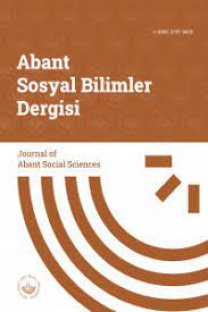ULUSLARARASI TİCARETTE EŞİTSİZ MÜBADELENİN ÖLÇÜLMESİ: TÜRKİYE ÖRNEĞİ
Eşitsiz mübadele, Satın alma gücü paritesi, Döviz kuru
___
- Alba, J.D. ve Park, D. (2005). “Non-linear Mean Reversion of Real Exchange Rates and Purchasing Power Parity: Some Evidence from Turkey”. Applied Economic Letters, 12, 701-704. Alba, J.D. ve Papell, D. H. (2007). “Purchasing Power Parity and Country Characteristics: Evidence from Panel Data Tests”. Journal of Development Economics, 83, 240−251. Amin, S. (1976). Unequal Development. New York: Monthly Review Press. Bahmani-Oskooeea, M., Kutanb, A. M. ve Zhou, S. (2008). “Do Real Exchange Rates Follow a Non-Linear Mean Reverting Process in Developing Countries?”. Southern Economic Journal, 74, 1049−1062. Bhagwati J. N. (1958), “Immiserizing Growth: A Geometrical Note”, Review of Economic Studies, No. 3, pp. 201-5. Boratav, K. (2009). Bir Krizin Hikayesi. Ankara: Arkadaş Yayınevi. Brewer, A. (1990). Marxist Theories of Imperialism: A Critical Survey. (Second Edition), London and New York: Routledge. Cheung, Y. ve Lai, K. (2000). “On Cross-Country Differences in The Persistence of Real Exchange Rates”. Journal of International Economics, 50, 375−397. Drine, Imed ve Rault, C. (2008). “Purchasing Power Parity for Developing and Developed Countries: What Can We Learn from Non-Stationary Panel Data Models?”. CESIFO Working Paper No.2255. Dollar, D. ve Kraay, A. (2004). “Trade, Growth, and Poverty”. The Economic Journal, 114 (February), F22. Emmanuel, A. (1972). Unequal Exchange: A Study Of The Imperialism Of Trade. New York: Monthly Review Press. Freeman, A. (2009). “The Poverty of Statistics and The Statistics of Poverty”. Thirld World Quarterly, 30:8, pp.1427-1448. Freeman, A. ve Kagarlitsky, B. (2008). Küreselleşmenin Krizi (1.baskı). İstanbul: Yordam Kitap. Froot, K.A. ve Rogoff, K. (1995). “Perspectives on PPP and Long-Run Real Exchange Rates”. In: Rogoff, K., Grossman, G. (Eds.), Handbook of International Economics. North Holland, Amsterdam. Gibson, B. (1980). “Unequal Exchange: Theoretical Issues and Empirical Findings”. The Review of Radical Political Economics, 12:3 (Feb.). Köhler, Gernot (1998). “The Structure of Global Money and World Tables of Unequal Exchange”. Journal of World-Systems Research 4:145-168. Köhler, G. (2003). “Time Series of Unequal Exchange”. G. Köhler ve E.J. Chaves (eds.), Globalization: Critical Perspectives (ss. 373-386) İçinde, New York: Nova Science Publishers, Inc. Kravis, I.B. ve Lipsey, R.E. (1983). “Toward An Explanation of National Price Levels”. NBER Working Paper No: 1034. MacDonalds, R. (2007). Exchange Rate Economics: Theories and Evidence. London: Routledge Taylor & Francis Group.. Reich, U. (2004). Inequality in International Trade. Paper prepared for the 28. General Conference of the International Association for Research in Income and Wealth, Cork, Ireland, August 22-28, 2004. Reich, U.P. (2006). Inequality in Exchange: The Use of a World Trade Table for Analyzing The International Economy. unpublished mimeo. Reich, U.P. (2007). “Inequality in Exchange: The Use of a World Trade Table for Analyzing The International Economy”. Economic Systems Research, 19:4, pp.375-395. Reich, U.P. (2013). “PPPs for SDRs? Some Theoretical Observations on How to Normalize, Capture The Dynamics, and Extend The Application of Global Purchasing Power Parities”. Journal of Economic and Social Measurement 38 (2013) pp. 171-185. Reich, U.P. (2014). Inequality in Global Production and Trade: A Proposal for Measurement. Paper prepared for the IARIW 33rd General Conference, Rotterdam, The Netherlands, August 24-30 2014. Rogoff, K. (1996). “The Purchasing Power Puzzle”. Journal of Economic Literature, 34, 647-668. Rosenberg, M.R. (1996). Currency Forecasting: A Guide To Fundamental and Technical Models of Exchange Rate Determination. McGraw Hill. Sarno, L. ve Taylor, M.P. (2002). “Purchasing Power Parity and The Real Exchange Rate”. IMF Staff Papers, 49, 65-105. Sarno, L., (2005). “Towards A Solution to The Puzzles in Exchange Rate Economics: Where Do We Stand?”. Canadian Journal of Economics 38, 673–708. Sawada, Y. ve Yotopoulos, P.A. (2006). “Growth and Poverty Reduction Under Globalization: The Systematic Impact of Exchange Rate Misalignment”. Stanford Center for International Development Working Paper No. 261. Somel, C. (2006). “Meta Zincirleri, Bağımlılık Ve Eşit Olmayan Gelişme”. A. H. Köse, F. Şenses ve E. Yeldan (der.) İktisadi Kalkınma, Kriz ve İstikrar, İstanbul: İletişim Yayınları, 3.Baskı, s. 561-578. Taylor, A.M. ve Taylor, M.P. (2004). “The Purchasing Power Debate”. Journal of Economic Perspective, 18, 135-158. Taylor, M.P. (2006). “Real Exchange Rates and Purchasing Power Parity: Mean-Reversion in Economic Thought”. Applied Financial Economics, 16, 1-17. TÜİK (2008), Satın Alma Gücü Paritesi: Sorularla Resmi Istatistikler Dizisi-4. Ankara: TÜİK Matbaası. Ünsal, E. (2005). Uluslararası İktisat: Teori, Politika, Ve Açık Ekonomi Makro İktisadı (1.Baskı). Ankara: İmaj Yayınevi. Ward, M. (2002). “Purchasing Power Parities Vs. Exchange Rates in International Comparisons”. Statistical Journal of the United Nations ECE ,19 (2002), 261-276. Webber, M.J. ve Foot, S.P.H. (1984). “The Measurement Of Unequal Exchange”. Environment and Planning A (vol.16). World Bank (2008). Global Purchasing Power Parities and Real Expenditures 2005. International Comparison Program. World Bank (2015). Purchasing Power Parities and The Real Size of World Economies: A Comprehensive Report of The 2011 International Comparison Program. Wu, J.-L, Cheng S. ve Han, H. (2010). “Further Evidence on Purchasing Power Parity and Country Charasterictics”. International Review of Economics and Finance.
- Yayın Aralığı: 3
- Başlangıç: 2000
- Yayıncı: Abant İzzet Baysal Üniversitesi Sosyal Bilimler Enstitüsü
KÖROĞLU TURİZMİNİN OLUŞTURULMASINDA FİLMLERİN ROLÜ
İNSAN KAYNAKLARI YÖNETİMİ BAĞLAMINDA İŞKOLİKLİK DAVRANIŞI ÜZERİNE BİR DEĞERLENDİRME
Serkan BAYRAKTAROĞLU, Sevdiye ERSOY YILMAZ, Emine ÇETİNEL
DUYGUSAL EMEK STRATEJİLERİNİN DUYGUSAL ZEKANIN TÜKENMİŞLİĞE ETKİSİNDEKİ ARACILIK ROLÜ
OKUL YÖNETİCİLERİNİN BİLGİ YÖNETİMİ VE İNSAN KAYNAKLARINI YÖNETİMİ YETERLİKLERİ
YEREL ÜRÜNLERİN TEŞVİKİ VE FİNANSMANI, BOLU İLİNİN DESTEKLERDEN YARARLANMA POTANSİYELİ
ULUSLARARASI TİCARETTE EŞİTSİZ MÜBADELENİN ÖLÇÜLMESİ: TÜRKİYE ÖRNEĞİ
